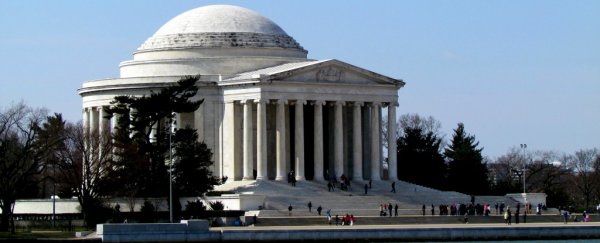Many major US monuments, including the Thomas Jefferson Memorial, are slowly turning from white to black, as biofilm - a catchall term for a group of microorganisms that come together to form slime - colonies start to run rampant in Washington DC.
Since research on biofilm is still in its infancy, the National Parks Service (NPS) is struggling to find ways to remove the slimy build up and restore the monuments back to their former glory.
"The increased presence of biofilm presents a new challenge in the care of memorials throughout the National Mall, particularly at the Thomas Jefferson Memorial," said Gay Vietzke, superintendent of the National Mall and Memorial Parks.
"We are continuing to study biofilm and research treatment methods, and look forward to restoring the dome to its original lustre while ensuring its long-term preservation."
Besides the Jefferson Memorial, the NPS reports that the biofilm - which they've not gone into specifics about yet - has also started to cover the Lincoln Memorial and some tombstones at the Congressional Cemetery. They also note that biofilm can be found on famous structures such as Hadrian's Villa in Italy and Angkor Wat in Cambodia.
The team suggests that the monuments are proving to be such a great place for biofilm to develop because the once-smooth marble stones that make up these structures are now pitted from constant weathering, providing an ideal location for colonies of biofilm to take root. Though, right now, it's all speculation.
"Treatment of biofilm is difficult, as there is no known permanent method for removing it, and we have to ensure that any treatment must not do further damage to the soft marble of the memorial nor encourage further growth," said resource manager Catherine Dewey, from the National Mall and Memorial Parks.
"We are testing a variety of treatment techniques to find the option that is least damaging to the stone, safe for the environment and visitors, and cost effective."
The build-up of biofilm on the Jefferson Memorial didn't happen overnight. The odd colonies were originally found back in 2006. By 2014, the problem had gotten so severe that a team of conservators, architects, and molecular biologists got together to try and deal with the issue.
Right now, the NPS and their team of biofilm warriors are testing 10 different chemicals on small patches of the memorial to see if they can hinder or kill the slime.
"There is no timeline for treatment of the dome and National Park Service officials stress that it's a deliberative process to ensure that whatever treatment is selected will do no further harm to the Jefferson Memorial," NPS officials said. "The treatment method ultimately chosen will help define the cost to restore the dome, which in turn drive the timeline for when the work will be scheduled."
Hopefully, the team can find a solution before the biofilm gets even thicker or starts coating other structures. But - based on how things have been going so far - it seems like they still have a long road ahead of them.
